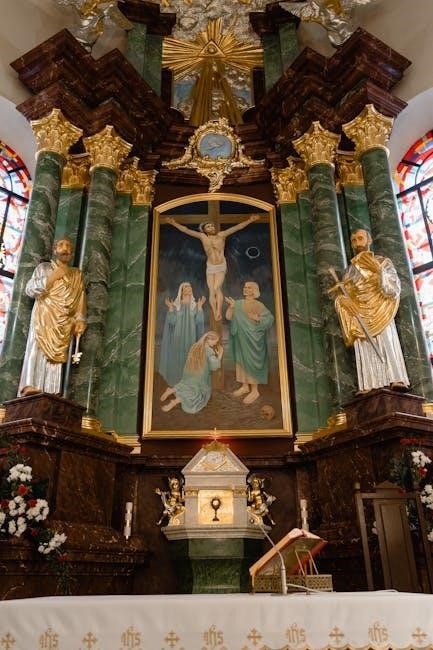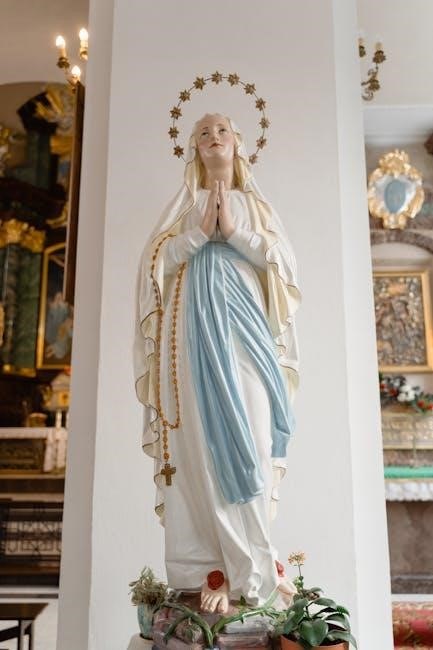jesus revealed in the tabernacle pdf
Jesus revealed in the tabernacle is a biblical concept explaining God’s plan of salvation through Jesus, as described in the scriptures, using the tabernacle as a symbol of redemption and forgiveness always.
Overview of the Tabernacle’s Significance
The tabernacle is a significant aspect of the biblical narrative, representing God’s dwelling place among His people. According to the scriptures, the tabernacle was a symbol of God’s presence and redemption. The tabernacle’s design and structure held deep spiritual meaning, with each element serving as a representation of God’s plan of salvation. The tabernacle was also a place of worship and sacrifice, where the Israelites would offer offerings to God. The significance of the tabernacle is still studied today, with many seeing it as a precursor to the coming of Jesus Christ. The tabernacle’s importance is evident in its repeated mention throughout the Bible, with many scholars believing it to be a crucial part of understanding God’s redemptive program. The study of the tabernacle provides valuable insights into the nature of God and His plan for humanity, making it a vital area of study for those seeking to deepen their understanding of the scriptures.

The Historical Background of the Tabernacle
The tabernacle originated in ancient Israel, with Moses receiving instructions from God on Mount Sinai, forming a sacred space for worship and sacrifice always in history records.
The Israelites and the Tabernacle’s Purpose
The Israelites played a significant role in the tabernacle’s purpose, as it served as a center of worship and sacrifice, with the high priest acting as a mediator between God and the people. The tabernacle’s design and layout were meant to symbolize God’s presence among the Israelites, with the altar of burnt offering and the bronze laver representing purification and atonement. The Israelites were instructed to follow specific rituals and ceremonies, such as the daily sacrifice and the feast of unleavened bread, to maintain their covenant with God. The tabernacle’s purpose was to provide a means for the Israelites to worship, atone for their sins, and maintain their relationship with God, ultimately pointing to the coming Messiah, Jesus Christ, who would fulfill the law and provide redemption for all people, as revealed in the scriptures and the tabernacle’s design.

The Salvation of Sinners Revealed in the Tabernacle
Salvation of sinners revealed through Jesus Christ, the tabernacle’s symbolism of redemption and forgiveness, as described in the scriptures, always pointing to God’s plan of salvation.
Yahweh the Living God and the Tabernacle
The tabernacle is a representation of Yahweh’s presence among the Israelites, a symbol of His covenant with them. According to the scriptures, Yahweh is the living God who called Moses to Mount Sinai to receive the plans for the tabernacle. The tabernacle’s design and building materials were specified by God Himself, emphasizing the importance of obedience and faithfulness. The Israelites’ offerings in the tabernacle were a way of worshiping and honoring Yahweh, acknowledging His sovereignty and provision. Through the tabernacle, Yahweh revealed His character and nature, demonstrating His love and mercy towards His people. The tabernacle serves as a reminder of God’s promise to dwell among His people, and its significance is still relevant today, pointing to the redemptive work of Jesus Christ. The tabernacle’s history and purpose are deeply rooted in the biblical narrative, revealing Yahweh’s plan of salvation.
Jesus in the Tabernacle
Jesus is the center of the tabernacle’s meaning, revealing God’s plan of salvation through His sacrifice and redemption always in the scriptures and biblical history records.
Kenneth Howe’s Perspective on Jesus in the TabernacleKenneth Howe’s perspective on Jesus in the tabernacle provides a unique understanding of God’s plan of salvation, as outlined in the scriptures and historical records, with a focus on the tabernacle’s design and purpose, and how it relates to Jesus’ role in redemption, according to the biblical account, and the significance of the tabernacle in the wilderness, and its relevance to the New Testament, and the importance of studying the tabernacle to understand God’s redemptive program, and how it is progressively revealed throughout the Bible, and the role of the tabernacle in the lives of the Israelites, and its symbolism in the New Testament, and the connection between the tabernacle and Jesus’ ministry, and the significance of the tabernacle in Christian theology, and its impact on Christian worship and practice, and the importance of understanding the tabernacle in the context of the Bible, and the value of Kenneth Howe’s perspective in deepening our understanding of Jesus in the tabernacle.

The Tabernacle’s Design and Building Materials
Tabernacle’s design and building materials specified in Exodus, including wood, gold, and fabrics, were used to construct the sanctuary, as described in the biblical account always.
The Importance of the Tabernacle’s Design
The tabernacle’s design is a crucial aspect of its significance, as it was carefully planned by God to represent His relationship with the Israelites. The design and layout of the tabernacle, including the outer court, holy place, and most holy place, held great symbolic meaning. The materials used, such as gold, wood, and fabrics, were also chosen for their specific properties and significance. The design of the tabernacle was meant to convey the idea of God’s presence and holiness, and to provide a means for the Israelites to worship and atone for their sins. The attention to detail in the tabernacle’s design is a testament to its importance in the biblical narrative, and its significance continues to be studied and appreciated by scholars and believers today, providing valuable insights into the nature of God and His plan of salvation.
The Tabernacle in the Wilderness
The tabernacle was a portable place of worship used by the Israelites during their journey through the wilderness, symbolizing God’s presence and guidance always freely.
The Tabernacle’s Role in the Wilderness
The tabernacle played a crucial role in the wilderness, serving as a symbol of God’s presence and guidance for the Israelites. It was a portable place of worship, designed by God Himself, and its construction was overseen by Moses. The tabernacle was a reminder of God’s covenant with His people and a foreshadowing of the redemption that would come through Jesus. The Israelites would gather around the tabernacle to offer sacrifices, pray, and worship, and it was also a place of refuge and protection. The tabernacle’s role in the wilderness was to provide a sense of community and unity among the Israelites, and to remind them of their dependence on God. Through the tabernacle, God revealed His plan of salvation and redemption, which would ultimately be fulfilled through Jesus. The tabernacle’s significance is still studied today, providing insight into God’s character and plan.

The Tabernacle as a Picture Book for Babes in Christ
The tabernacle is a picture book for babes in Christ, symbolizing God’s redemption plan, revealing Jesus’ role in salvation, and guiding believers in their spiritual journey always.
The Tabernacle’s Significance in the New Testament
The tabernacle’s significance in the New Testament is a crucial aspect of understanding Jesus’ role in salvation, as it symbolizes God’s plan of redemption and forgiveness. The New Testament reveals the tabernacle as a precursor to Jesus’ ministry, with Jesus being the ultimate sacrifice and high priest. The tabernacle’s design and furnishings are also seen as symbolic of Jesus’ life and ministry, with the altar of sacrifice representing Jesus’ death on the cross. The tabernacle’s significance is further emphasized by the fact that it is mentioned numerous times in the New Testament, highlighting its importance in understanding God’s plan of salvation. The New Testament also reveals the tabernacle as a type of heavenly sanctuary, with Jesus serving as the high priest in the heavenly tabernacle. This understanding is essential for believers to comprehend the depth of God’s love and redemption plan.
